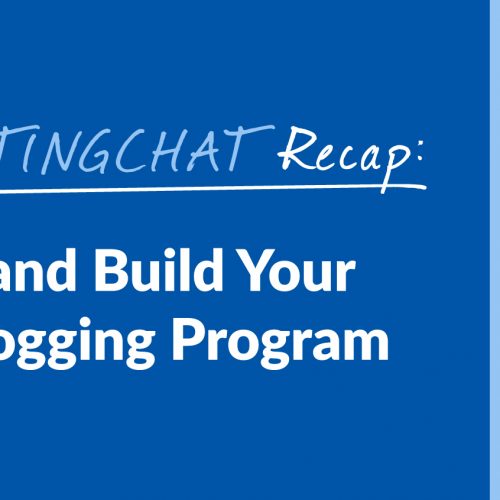A Case Study in Blogging: 21,600 Keyword Rankings in Google and 90,000 Visitors Per Month
This May, we’re celebrating our 8th full year of business at Express Writers. Looking back, it doesn’t even feel like eight years. More like a century. (Just kidding!) Seriously, though, I’m thankful that we’re here this May. Eight years is nothing to sneeze at. Just look at these statistics from Motley Fool: 80% of new businesses survive past their first year of operation. 50% of businesses make it to five years. And only 33% of businesses make it to ten years. Considering that I started this entire operation back in 2011 with an investment of the crumbs left in my broke-college-student savings account, $75, I’m thrilled that we’ve made it this far. With a 100% chance of failure, I rolled up my sleeves and put in many 60 and even 90-hour work weeks in the beginning. We kept chugging along, growing at incredible speeds every year. As I was digging into ideas to write a blog to celebrate our eighth year here on the Write Blog, it hit me that we didn’t have any fresh case studies on our blogging traffic and analytics, which have recently been the highest they’ve ever been. It also came to my mind the current state of affairs: how many content marketers and blog publishers are still struggling to even see success from their online efforts. So, this case study is needed. If you read one blog from me this year, make it this one. A Case Study in Blogging: 21,600 Keyword Rankings in Google and 90,000 Visitors Per Month Let’s dive into my blogging case study! First, let’s talk about the beginning (strategy), and the end (results). The Power of, and Strategy Involved In, Brand Blogging that Works Fun fact: Blogging used to be just for the people that “journaled their thoughts” on the web. The idea of blogging online itself originated in 1994, when a college student named Justin Hall began a stint of “personal blogging” that lasted eleven years. He was enrolled at Swarthmore College in Pennsylvania. Originally, the words “escribitionists” and “weblog” were used to describe what is now known as “blog.” Thank goodness that word evolved! Blogging is now far more than just an online diary. It’s a huge opportunity for businesses, brands and marketers to express themselves to their audience, grow and build a real community, and share the authentic real “human side” behind the brand. Blogging is a #1 method for marketers and brands to add consistent new site traffic that may eventually convert and become a buyer. At Express Writers, I’ve managed to write and publish over 1,100 blogs on our site over the past eight years, with the help of my team. The amount of content we publish on our blog, the consistency of it, and the quality and relevancy of our blog posts are the biggest factors behind what is now 90,000+ visitors/month coming to our site: We have 1,188 blogs published to date since 2012, the year I began consistently blogging. That’s an average of 169 blogs published per year. Our traffic went up steadily over the years, increasing when we put an emphasis on quality over quantity of content in late 2016 and ramped up in 2017. Our quality > quantity emphasis that began in 2016 focused on a few things: implementing a real content strategy for the first time and going from publishing four blogs/week to 1-2 high-quality blogs/week. Here’s a timeline tracking our biggest historic growth points, pulled from this blog I wrote on content strategy and my masterclass on how to build a strong content strategy. Right around the time we focused on a content strategy and quality over quantity, our results started to shoot through the roof. The data speaks. Check out how our SEO tracking in SEMrush reflects a spike in growth right around the time we built a content strategy and emphasized quality over quantity: Last week, when I was giving a talk on content creation right here in Austin, Texas, I shared these two slides that sums up our content success story well. The Google Analytics screenshot below was from March of this year, and this April, we had our first 90,000 traffic/month. Smart marketers shouldn’t be too excited by these numbers until they see the conversion rate and the sales. (Mr. Wonderful on Shark Tank, anyone? “Talk numbers!”) On average, we are achieving the benchmark conversion statistic for organic search traffic. 14-16% of our leads are converting. As Mr. Wonderful would say, “To cash flow!” Now, here’s what our traffic numbers look like as of writing this blog over late April 2019. Our Google Analytics: On the right, in the blue box, you can see how 10 out of these 14 visitors are on a blog post the moment this screenshot was taken. This is very common for our traffic. Now, check out our SEO ranking statistics in SEMrush again. We’re at 21,600 keyword rankings in Google. I have the graph set to “all-time”, so this is going back to May 2013, when I first started a SEMrush tracking project for our site. I’m in love with the traffic growth shown in this graph that spiked beginning in 2017, which is the year we got strategic. Learn more about how getting strategic paid off for us, here. Because of the content geeks we are and how consistent our content is, Google loves our site. Plus, everything we do is always organic, audience-first, and ethical. I never pay a dime in PPC ads, and we don’t allow advertisers to ever have access to our site or blog (even though I’m pitched at least once per day). You can see proof of our Domain Authority with expresswriters.com in Alexa, Amazon’s pioneer in the world of analytical website insight. Alexa clocks us at being the 97,000th-most popular website in the world, which is pretty crazy given there are over 1.6 billion websites in the world (InternetLiveStats). As for our content creation itself: everything — everything — we publish and create on our site is focused around several key things: Offering real value, factual and statistical (real) insights, truly useful … Read more






